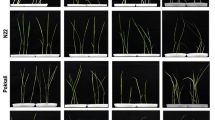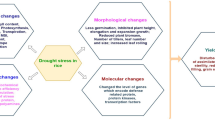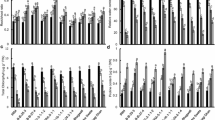Abstract
Drought is a vice to world crop production, exponentially enhanced by global climate change. Rice, a basic food crop for a major chunk of world populace, is largely affected by environmental challenges such as drought, salinity and heavy metal. This study brings to limelight differential drought tolerance capacity of rice varieties indigenous to North East India, a hot bed of indica rice diversity. Initial screening of rice varieties were performed through physiological dose-dependent studies under PEG (0%, 10%, and 20% which is equal to osmotic potential values of 0.001, 0.54 and 1.09 MPa, respectively), induced drought stress for three time intervals of 1, 3 and 5 days. Hierarchical clustering of the parameters on which the cultivars were analysed revealed Tampha and KMJ 1-12-3 to be relatively more tolerant whereas Chandan and Ketaki Joha as the sensitive ones. Biochemical studies for hydrogen peroxide (H2O2), proline, lipid peroxidation (MDA), lipoxygenase (LOX), superoxide dismutase (SOD), catalase (CAT), guaiacol peroxidase (POX), dehydroascorbate reductase (DHAR), monodehydroascorbate reductase (MDHAR) and glutathione reductase (GR) were then performed on two cultivars (Tampha and Chandan) to elucidate the differential tolerance to drought, focusing on anti-oxidative response mechanism. The biochemical fingerprint showed significantly lower accumulation of H2O2 and MDA; higher accumulation of proline; and higher activity of SOD, CAT, DHAR, MDHAR and GR in the tolerant variety Tampha when compared to Chandan. In addition, alteration of chlorophyll fluorescence due to stress was also monitored to ascertain the variation in photosynthetic efficiency between the tolerant and sensitive cultivars. Tampha showed better photosynthetic activity in comparison to Chandan as quantified by measuring chlorophyll fluorescence. This manuscript thus throws new light into the drought stress response of the varieties from North East India with global implications.









Similar content being viewed by others
References
Ali MN, Yeasmin L, Gantait S, Goswami R, Chakraborty S (2014) Screening of rice landraces for salinity tolerance at seedling stage through morphological and molecular markers. Physiol Mol Biol Plants 20(4):411–423
Anjum SA, Xie XY, Wang LC, Saleem MF, Man C, Lei W (2011) Morphological, physiological and biochemical responses of plants to drought stress. Afr J Agric Res 6(9):2026–2032
Annual Report IRRI (2016). https://irri.org/resources-and-tools/publications
Awasthi J, Saha B, Chowardhara B, Devi S, Borgohain P, Panda S (2018) Qualitative analysis of lipid peroxidation in plants under multiple stress through schiff’s reagent: a histochemical approach. Bioprotocol 8(8):e2807. https://doi.org/10.21769/BioProtoc.2807
Axelrod B, Cheesbrough TM, Laakso S (1981) Lipoxygenase from soybeans. Methods Enzymol 71:441–451
Basu S, Roychoudhury A, Saha PP, Sengupta DN (2010) Differential antioxidative responses of indica rice cultivars to drought stress. Plant Growth Regul 60(1):51
Bates LS, Walden RP, Teare ID (1973) Rapid determination of free proline for water-stress studies. Plant Soil 39(1):205–207
Bhaskara GB, Wen TN, Nguyen TT, Verslues PE (2017) Protein phosphatase 2Cs and microtubule-associated stress protein 1 control microtubule stability, plant growth, and drought response. Plant Cell Online 29(1):169–191
Chance B, Maehly AC (1955) Assay of catalases and peroxidases. Methods Enzymol 2:764–775
Cheng F, Lu J, Gao M, Shi K, Kong Q, Huang Y et al (2016) Redox signaling and CBF-responsive pathway are involved in salicylic acid-improved photosynthesis and growth under chilling stress in watermelon. Front Plant Sci 7:519. https://doi.org/10.3389/fpls.2016.01519
Cruz de Carvalho MH (2008) Drought stress and reactive oxygen species: production, scavenging and signaling. Plant Signal Behav 3(3):156–165
Das A, Ghosh PK, Lal R, Saha R, Ngachan S (2017) Soil quality effect of conservation practices in maize–rapeseed cropping system in Eastern Himalaya. Land Degrad Dev 28(6):1862–1874
Devi LJ (2014) Evaluation of some common rice varieties of Manipur for resistance against rice root-knot nematode. Eur J Biotechnol Biosci 1(3):39–41
Fang Y, Xiong L (2015) General mechanisms of drought response and their application in drought resistance improvement in plants. Cell Mol Life Sci 72(4):673–689
Foyer CH, Noctor G (2011) Ascorbate and glutathione: the heart of the redox hub. Plant Physiol 155(1):2–18
Giannopolitis CN, Ries SK (1977) Superoxide dismutases: I. Occurrence in higher plants. Plant Physiol 59(2):309–314
Gill SS, Tuteja N (2010) Reactive oxygen species and antioxidant machinery in abiotic stress tolerance in crop plants. Plant Physiol Biochem 48(12):909–930
Griggs D, Stafford-Smith M, Gaffney O, Rockström J, Öhman MC, Shyamsundar P, Noble I (2013) Policy: sustainable development goals for people and planet. Nature 495(7441):305–307
Hasanuzzaman M, Nahar K, Rahman A, Inafuku M, Oku H, Fujita M (2018) Exogenous nitric oxide donor and arginine provide protection against short-term drought stress in wheat seedlings. Physiol Mol Biol Plants 24:1–12
Heath RL, Packer L (1968) Photoperoxidation in isolated chloroplasts. Arch Biochem Biophys 125(1):189–198
Hellal FA, El-Shabrawi HM, El-Hady MA, Khatab IA, El-Sayed SAA, Abdelly C (2018) Influence of PEG induced drought stress on molecular and biochemical constituents and seedling growth of Egyptian barley cultivars. J Genet Eng Biotechnol 16(1):203–212
Hoagland DR, Arnon DI (1950) The water-culture method for growing plants without soil. Circ Calif Agric Exp Stn 347:1–39
Huang L, Li M, Shao Y, Sun T, Li C, Ma F (2018) Ammonium uptake increases in response to PEG-induced drought stress in Malus hupehensis Rehd. Environ Exp Bot 151:32–42
Joshi R, Anwar K, Das P, Singla-Pareek SL, Pareek A (2017) Overview of methods for assessing salinity and drought tolerance of transgenic wheat lines. In: Wheat biotechnology. Humana Press, New York, pp 83–95
Kang GZ, Li GZ, Liu GQ, Xu W, Peng XQ, Wang CY, … Guo TC (2013) Exogenous salicylic acid enhances wheat drought tolerance by influence on the expression of genes related to ascorbate-glutathione cycle. Biologiaplantarum 57(4):718–724
Kocsy G, Brunner M, Rüegsegger A, Stamp P, Brunold C (1996) Glutathione synthesis in maize genotypes with different sensitivity to chilling. Planta 198:365–370
Kooyers NJ (2015) The evolution of drought escape and avoidance in natural herbaceous populations. Plant Sci 234:155–162
Liu T, Sheng M, Wang CY, Chen H, Li Z, Tang M (2015) Impact of arbuscular mycorrhizal fungi on the growth, water status, and photosynthesis of hybrid poplar under drought stress and recovery. Photosynthetica 53(2):250–258
Lu HB, Qiao YM, Gong XC, Li HQ, Zhang Q, Zhao ZH, Meng LL (2015) Influence of drought stress on the photosynthetic characteristics and dry matter accumulation of hybrid millet. Photosynthetica 53(2):306–311
Ma F, Cheng L (2004) Exposure of the shaded side of apple fruit to full sun leads to upregulation of both the xanthophyll cycle and the ascorbate–glutathione cycle. Plant Sci 166(6):1479–1486
Ma NL, Lah WAC, Kadir NA, Mustaqim M, Rahmat Z, Ahmad A et al (2018) Susceptibility and tolerance of rice crop to salt threat: physiological and metabolic inspections. PLoS One 13(2):e0192732
McCabe GJ, Wolock DM (2015) Variability and trends in global drought. Earth Space Sci 2(6):223–228
Miyake C, Asada K (1992) Thylakoid-bound ascorbate peroxidase in spinach chloroplasts and photoreduction of its primary oxidation. Plant Cell Physiol 33:541–553
Mostofa MG, Hossain MA, Fujita M, Tran LSP (2015) Physiological and biochemical mechanisms associated with trehalose-induced copper-stress tolerance in rice. Sci Rep 5:11433. https://doi.org/10.1038/srep11433
Munne-Bosch S, Pinto-Marijuan M (2016) Free radicals, oxidative stress and antioxidants. Encycl Appl Plant Sci 2:16–19
Nakano Y, Asada K (1981) Hydrogen peroxide is scavenged by ascorbate-specific peroxidase in spinach chloroplasts. Plant Cell Physiol 22(5):867–880
Nguyen TTT, Klueva N, Chamareck V, Aarti A, Magpantay G, Millena ACM, Nguyen HT (2004) Saturation mapping of QTL regions and identification of putative candidate genes for drought tolerance in rice. Mol Genet Genom 272(1):35–46
Omisun T, Sahoo S, Saha B, Panda SK (2018) Relative salinity tolerance of rice cultivars native to North East India: a physiological, biochemical and molecular perspective. Protoplasma 255(1):193–202
Ramel F, Sulmon C, Bogard M, Couée I, Gouesbet G (2009) Differential patterns of reactive oxygen species and antioxidative mechanisms during atrazine injury and sucrose-induced tolerance in Arabidopsis thaliana plantlets. BMC Plant Biol 9(1):28
Rao MV, Davis KR (1999) Ozone-induced cell death occurs via two distinct mechanisms in Arabidopsis: the role of salicylic acid. Plant J 17(6):603–614
Rejeb KB, Abdelly C, Savouré A (2014) How reactive oxygen species and proline face stress together. Plant Physiol Biochem 80:278–284
Sagisaka S (1976) The occurrence of peroxide in a perennial plant Populasgelrica. Plant Physiol 57:308–309
Saha B, Mishra S, Awasthi JP, Sahoo L, Panda SK (2016a) Enhanced drought and salinity tolerance in transgenic mustard [Brassica juncea (L.) Czern&Coss.] overexpressing Arabidopsis group 4 late embryogenesis abundant gene (AtLEA4-1). Environ Exp Bot 128:99–111
Saha B, Borovskii G, Panda SK (2016b) Alternative oxidase and plant stress tolerance. Plant signal Behav 11(12):e1256530
Sahoo S, Awasthi JP, Sunkar R, Panda SK (2017) Determining glutathione levels in plants. In: Plant stress tolerance. Humana Press, New York, pp 273–277
Schutzendubel A, Schwanz P, Teichmann T, Gross K, Langenfeld-Heyser R, Godbold DL, Polle A (2001) Cadmium-induced changes in antioxidative systems, hydrogen peroxide content, and differentiation in Scots pine roots. Plant Physiol 127(3):887–898
Sheng M, Tang M, Chen H, Yang B, Zhang F, Huang Y (2008) Influence of arbuscular mycorrhizae on photosynthesis and water status of maize plants under salt stress. Mycorrhiza 18(6–7):287–296
Shigeoka S, Ishikawa T, Tamoi M, Miyagawa Y, Takeda T, Yabuta Y, Yoshimura K (2002) Regulation and function of ascorbate peroxidase isoenzymes. J Exp Bot 53(372):1305–1319
Siddiqui MN, Mostofa MG, Akter MM, Srivastava AK, Sayed MA, Hasan MS, Tran LSP (2017) Impact of salt-induced toxicity on growth and yield-potential of local wheat cultivars: oxidative stress and ion toxicity are among the major determinants of salt-tolerant capacity. Chemosphere 187:385–394
Smith IK, Vierheller TL, Thorne CA (1988) Assay of glutathione reductase in crude tissue homogenates using 5,5′-dithiobis(2-nitrobenzoic acid). Anal Biochem 175(2):408–413
Sofo A, Dichio B, Xiloyannis C, Masia A (2004) Lipoxygenase activity and proline accumulation in leaves and roots of olive trees in response to drought stress. PhysiologiaPlantarum 121(1):58–65
Sun J, Hu W, Zhou R, Wang L, Wang X, Wang Q et al (2015) The Brachypodiumdistachyon BdWRKY36 gene confers tolerance to drought stress in transgenic tobacco plants. Plant Cell Rep 34(1):23–35
Todaka D, Zhao Y, Yoshida T, Kudo M, Kidokoro S, Mizoi J, Toyooka K (2017) Temporal and spatial changes in gene expression, metabolite accumulation and phytohormone content in rice seedlings grown under drought stress conditions. Plant J 90(1):61–78
Van Aken O, Van Breusegem F (2015) Licensed to kill: mitochondria, chloroplasts, and cell death. Trends Plant Sci 20(11):754–766
Wu Z, Zhao X, Sun X, Tan Q, Tang Y, Nie Z, Hu C (2015) Antioxidant enzyme systems and the ascorbate–glutathione cycle as contributing factors to cadmium accumulation and tolerance in two oilseed rape cultivars (Brassica napus L.) under moderate cadmium stress. Chemosphere 138:526–536
Yang Z, Dai Z, Lu R, Wu B, Tang Q, Xu Y et al (2017) Transcriptome analysis of two species of jute in response to polyethylene glycol (PEG)-induced drought stress. Sci Rep 7(1):16565
Zandalinas SI, Balfagón D, Arbona V, Gómez-Cadenas A (2017) Modulation of antioxidant defense system is associated with combined drought and heat stress tolerance in citrus. Front Plant Sci 8:953
Acknowledgements
We highly acknowledge Regional Agricultural Research Station (RARS), Akbarpur (Karimganj), Assam, India; Regional Rainfed Lowland Rice Research Station (RRLRRS) Gerua, Assam, India; and Central Agriculture University (CAU), Imphal, Manipur, India for supplying us with valuable rice seeds.
Author information
Authors and Affiliations
Corresponding author
Ethics declarations
Conflict of interest
The authors declare that they have no competing interest.
Additional information
Communicated by K. Apostol.
Publisher’s Note
Springer Nature remains neutral with regard to jurisdictional claims in published maps and institutional affiliations.
Electronic supplementary material
Below is the link to the electronic supplementary material.
Rights and permissions
About this article
Cite this article
Sahoo, S., Saha, B., Awasthi, J.P. et al. Physiological introspection into differential drought tolerance in rice cultivars of North East India. Acta Physiol Plant 41, 53 (2019). https://doi.org/10.1007/s11738-019-2841-x
Received:
Revised:
Accepted:
Published:
DOI: https://doi.org/10.1007/s11738-019-2841-x




